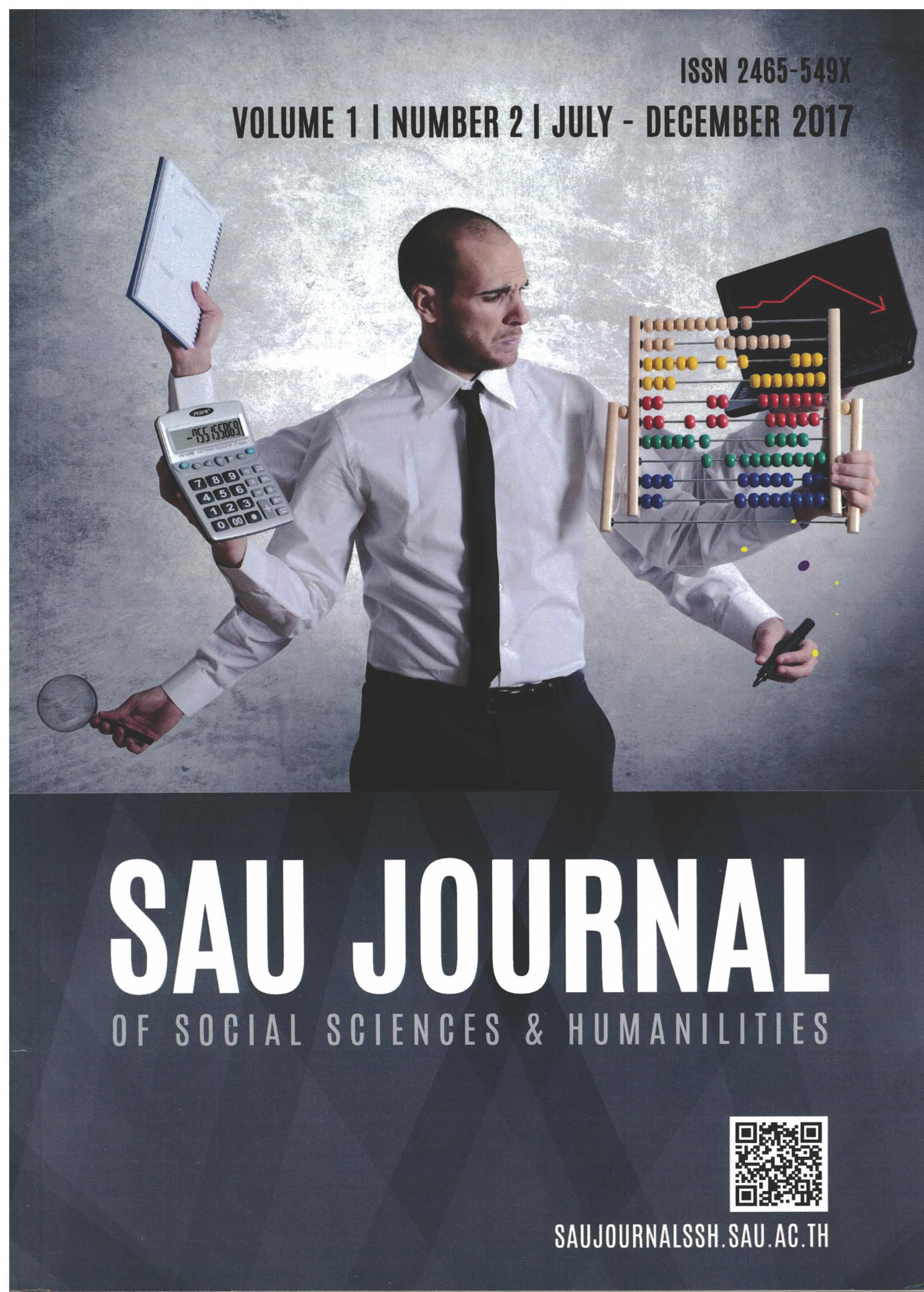อิทธิพลของตัวแปรกำกับการบูรณาการความรู้ที่ถ่ายโอนความสัมพันธ์ระหว่างการบริหารคนเก่งสู่ความได้เปรียบในการแข่งขันอย่างยั่งยืนของอุตสาหกรรมอิเล็กทรอนิกส์ไทย
คำสำคัญ:
การบริหารคนเก่ง, การบูรณาการความรู้, ความได้เปรียบในการแข่งขันอย่างยั่งยืนบทคัดย่อ
การศึกษาครั้งนี้มีวัตถุประสงค์เพื่อ (1) ศึกษาระดับการบริหารคนเก่ง การบูรณาการความรู้ และความได้เปรียบในการแข่งขันอย่างยั่งยืนของอุตสาหกรรมอิเล็กทรอนิกส์ไทย และ (2) ศึกษาอิทธิพลของตัวแปรกำกับการบูรณาการความรู้ที่ถ่ายโอนความสัมพันธ์ระหว่างการบริหารคนเก่งสู่ความได้เปรียบในการแข่งขันอย่างยั่งยืนของอุตสาหกรรมอิเล็กทรอนิกส์ไทย โดยกลุ่มตัวอย่างที่ใช้ในการวิจัย คือ ผู้ประกอบการอุตสาหกรรมอิเล็กทรอนิกส์ไทย จำนวน 100 ตัวอย่าง สถิติที่ใช้ในการวิจัยเป็นการวิเคราะห์ตัวแบบสมการโครงสร้างด้วยโปรแกรม PLS Graph 3.0 ผลการศึกษา พบว่า 1) การบริหารคนเก่ง การบูรณาการความรู้ และความได้เปรียบในการแข่งขันอย่างยั่งยืน มีค่าเฉลี่ยรวมอยู่ในระดับมาก และ 2) อิทธิพลของตัวแปรกำกับการบูรณาการความรู้ไม่มีอิทธิพลต่อการเข้ามาถ่ายโอนความสัมพันธ์ระหว่างการบริหารคนเก่งสู่ความได้เปรียบในการแข่งขันอย่างยั่งยืนของอุตสาหกรรมอิเล็กทรอนิกส์ไทย
References
[2] ธัญนันท์ บุญอยู่, นิภา รุ่งเรืองวุฒิไกร, มนตรี พิริยะกุล, และนภาพร ขันธนภา. (2559) อิทธิพลคั่นกลางแบบอนุกรมของทุนทางปัญญาและการเป็นผู้ประกอบการในการถ่ายทอดวัฒนธรรมองค์การสู่ผลการดำเนินงานสำหรับอุตสาหกรรมต่อตัวถังรถโดยสาร. วารสารดุษฎีบัณฑิตทางสังคมศาสตร์ (ฉบับมนุษย์ศาสตร์และสังคมศาสตร์), 6(1), 78-94.
[3] มนตรี พิริยะกุล, และบุญฑวรรณ วิงวอน. (2553). ตัวแบบเส้นทาง PLS ของปัจจัยพหุกลุ่มในการสร้างความได้เปรียบในการแข่งขันของกลุ่มวิสาหกิจขนาดกลางและขนาดย่อม. ค้นเมื่อ 14 มีนาคม 2557, จาก http://www.mgts.lpru.ac.th/ mgts/data_file/128452748916.doc.
[4] มนตรี พิริยะกุล. (2553). ตัวแปรเส้นทางกำกลังสองน้อยที่สุดบางส่วน. กรุงเทพฯ: สำนักพิมพ์มหาวิทยาลัยรามคำแหง.
[5] มนตรี พิริยะกุล. (2558). ตัวแปรคั่นกลางและการ ทดสอบอิทธิพลทางอ้อม. วารสารการจัดการและการพัฒนา, 2(1), 11-31.
[6] สถาบันไฟฟ้าและอิเล็กทรอนิกส์. (2560). รายงานสถานการณ์อุตสาหกรรมไฟฟ้าและอิเล็กทรอนิกส์ข้อมูลเดือนมกราคม 2560. ค้นเมื่อ 25 มีนาคม 2560 จาก http:// www.thaieei.com/ 2013/th/ index.php
[7] สุดาว เลิศวิสุทธิไพบูลย์. (2558). การบูรณาการ: ปัจจัยสำคัญของการจัดการความรู้ยุคใหม่. จุลสารสาขาวิชาวิทยาศาสตร์สุขภาพออนไลน์, 4(2558), 1-3.
[8] Agha, S., Alrubaiee, L., & Jamhour, M. (2012). Effect of core competence on competitive advantage and organizational performance. International Journal of Business and Management, 7(1), 192-204.
[9] Alias, N. E., Noor, N. M., & Hassan, R. (2014). Examining the mediating effect of employee engagement on the relationship between talent management practices and employee retention in the information and technology (IT) organizations in Malaysia. Journal of Humana Resources Management and Labor Studies, 2(2), 227-242.
[10] Almaaitah, M. A., Al-Shalabi, F. S., & Aljamal, W. H. (2013). Talen management and competitive advantage: The moderating effect of knowledge integration. International Journal of Computer Applications, 66(11), 19-27.
[11] Almor, T., & Hashai, N. (2004). The competitive advantage and strategic configuration of knowledge-intensive, small-and medium-sized multinationals: A modified resource-based view. Journal of International Management, 10(4), 479-500.
[12] Cater, T., & Cater, B. (2009). (In) tangible resources as antecedents of a company’s competitive advantage and performance. Journal for East European Management Studies, 14(2), 186-209.
[13] Kim, W. C., & Mauborgne, R. (2004). Blue ocean strategy. Cambridge, MA: Harvard Business School Press.
[14] Macmillan, H., & Tampo, M. (2000). Strategic management. Oxford University Press.
[15] Porter , M. E. (1985). Competitive advantage: Creating and sustaining superior performance. New York: Free Press.
[16] Shadfard, S., Zeinali, M., & Zekalab, M. (2013). The comparison between knowledge management and entrepreneurship culture on competitive advantage in manufacturing company of Gilan. Interdisciplinary Journal of Contemporary Research in Business, 5(1), 1029-1036.
[17]Sun, P. (2010). Five critical knowledge management organizational themes. Journal of Knowledge Management, 14(4), 507-523.
[18]Urbancova, H., & Vnouckova, L. (2015). Investigating talent management Philosophies. Journal of Competitiveness, 7(3), 3-18.
[19]Whelan, E. & Carcary, M. (2011). Integrating talent and knowledge management: where are the benefits?. Journal of Knowledge Management, 15(4), 675-687.





